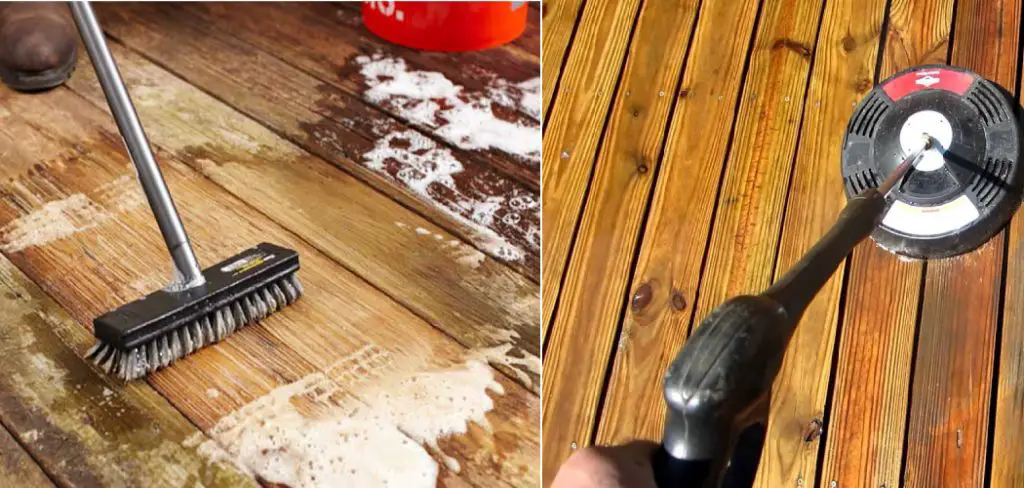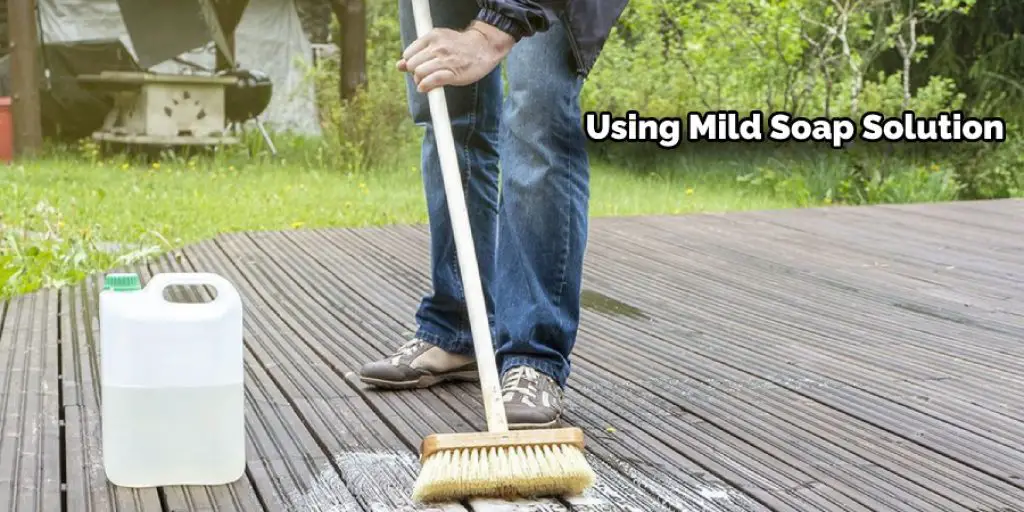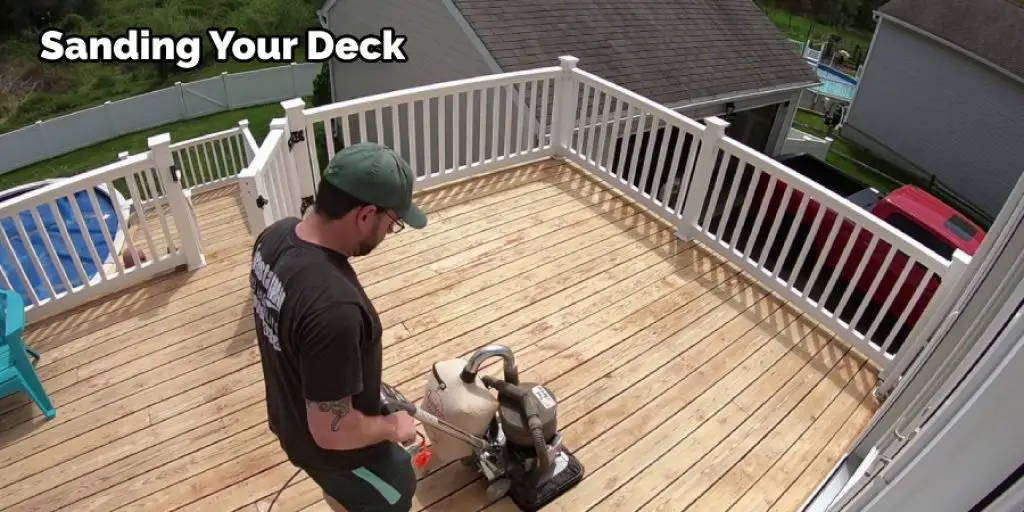After a long, hot summer season of barbecues and family gatherings, it’s time to clean the deck. While this may seem like an easy task, just sweep off the surface and then hose down; many factors can influence how well your deck is cleaned.
There are also some precautions you should take before cleaning your wood deck. One key factor in keeping your deck clean is understanding what type of wood is made out of cedar or pressure-treated lumber? Knowing which one you have will help determine the best method for cleaning it.

Cedar decks require different cleaners than those made from pressure-treated lumber, as they do not rot as quickly because their natural oils protect them from insects and weathering. In this article, we’ll explore how to clean a wood deck without a pressure washer.
Step to Follow on How to Clean a Wood Deck Without a Pressure Washer
Step One: Scrape Away Excess Dirt
Use a hand or electric-powered scraper to remove any excess dirt that may be on the deck. It is recommended that you use the traditional manual scraper for this step, as it will give you better control while removing excess dirt. While cleaning your deck without a pressure washer, some people recommend placing plastic under your feet to avoid the inevitable splintering.
This may not be necessary, especially if you are very careful and thorough throughout this process and wear shoes that won’t cause too many splinters. Some also recommend Carpenter’s pencils to mark areas that have been cleaned because this makes it much easier to see the spots that need another sweep or scrape.
Step Two: Use a Mild Soap Solution
Mix one cup TSP-PF, one gallon of warm water, and two tablespoons of dishwashing liquid. Stir until all the powder has dissolved. This can be done by hand or with an electric mixer next; useuse the wheeled brush to apply your cleaning solution to your deck boards to break up anything that may be left on the wood.

When cleaning a large area with this solution, one thing to consider is to avoid puddles of water or other wet spots, as they can damage your deck boards. Also, saturating your deck boards with soapy water is not as effective as simply using a gentle scrubbing motion that releases the dirt and grime.
Step Three: Rinse and Scrub
Use a hose to rinse your deck with clean water. Ensure that you do not leave any soap residue on the wood by using a gentle spray and letting it drain away. Now use the wheeled brush to scrub lightly at the deck boards to remove any dirt or residues still left behind.
You can also use a soft cloth for this step if you need extra control. Finally, you can use a push or pull motion on the deck boards to get them clean, but be sure that you are applying enough pressure for your brush bristles to reach into the crevices of your wood.
Step Four: Allow Wood to Dry
Before you move on to oiling, sanding, or painting your deck boards, make sure they are fully dry. Place a fan near the deck to help it dry more quickly, and avoid attempting to walk on your wood until you are certain it is scorched. This will prevent any slipping or injuries that could result.
After your deck boards are dry, you can begin the finishing process. This includes sanding the deck boards to remove any splinters or rough areas, priming, painting, filling cracks, adding sealant for added protection against weather damage, and oiling with a penetrative sealer that will keep your wood healthy.
Step Five: Applying Penetrating Wood Sealant
This is an optional step but one that may be beneficial to your deck. There are many different questions you can ask yourself about applying a penetrative sealer, such as if it will keep the beauty of the natural wood grain while protecting it from any weather damage.

To answer this question, follow the instructions provided by the product’s manufacturer. Once you have finished applying your sealant to your deck, it is also a good idea to inspect the areas that were covered in the dirt during removal and clean them again to ensure that they are completely free of anything that could cause damage or allow an easy entrance for further weather damage like moisture and mildew.
Step Six: Oil, Your Deck
There are a few different types of oil you can use on your deck, and each one will provide a different result. For example, some oils penetrate deeply into the wood while others coat it with a protective layer easily removed by rain or other wetness.
One thing to consider when choosing oil for your deck is whether you want it to be natural or not. Natural oils like canola oil will soak into your wood over time, while synthetic oils like linseed oil are typically used more for their protective qualities. This will help in how to clean a wood deck without a pressure washer.
Step Seven: Sanding Your Deck
You may find that your deck requires some sanding to get any splinters out or remove small areas of damage. If this is the case, follow your deck manufacturer’s instructions for the proper process to minimize damage while still getting the results you want.

Once you have sanded your deck boards, it is also good to inspect all of them for any areas you may have missed when cleaning. If your deck has boards of different colors, make sure to inspect underneath them for any dirt or grime that might be hiding out of sight.
You Can Check It Out to: Clean Paving Slabs Without a Pressure Washer
Frequently Asked Questions
Can You Clean a Wood Deck Without A Power Washer?
Yes, you can clean a wood deck without a power washer. There are some things that you need to do before and after cleaning your deck to make sure it stays looking great for years to come.
Before you start cleaning your deck, make sure the area is free of leaves or other debris that may cause damage while you’re working. Next, scrub off any dirt and stains with an old toothbrush or scrub brush, then rinse the surface thoroughly with water. For tougher stains like oil or tar, mix up some dish soap with warm water and use a sponge on the surface until it’s clean. If this doesn’t work, apply a solution of 1/2 cup bleach mixed with 1 gallon of water as directed by the product’s instructions (usually one tablespoon per gallon). Let this sit for 10 minutes before rinsing off again.
What Is the Best Way to Clean a Wooden Deck?
There are many ways to clean a wooden deck, but the best way is to use a pressure washer. A pressure washer is an excellent tool for cleaning decks because it can reach deep into crevices and clean them effectively. It also removes dirt, dust, mildew, mold, mildew stains, and bird droppings that may be hiding in cracks or under boards.
Will Bleach Damage Wood Deck?
Bleach is a very powerful and effective cleaning agent that can be used to clean many surfaces, including wood. However, there are some things you should keep in mind before using bleach on your deck.
- Bleach should not be used on any porous surface or material because it will damage the wood underneath.
- When applying bleach to wood, make sure that you don’t have anything that would react with the bleach-like paint or varnish.
- You should also avoid using bleach on unfinished wood or painted surfaces because it may cause discoloration of the paint or stain.
Can I Clean My Deck with Vinegar?
Yes, vinegar is a great cleaning agent. It can be used to clean many surfaces like concrete, metal, plastic, and wood.
You can also use it to clean your deck with a solution of half water and half white vinegar mixed together. It will work in two ways: firstly, by removing any dirt or grime on the surface of the deck, and secondly, by killing off any fungus that may have spread on the surface of the deck.
Is Deck Wash Necessary?
Deck wash is necessary for a variety of reasons.
The main reason to use deck wash is that it helps keep the wood from rotting and gives it a new look and feel. Wood rot can be caused by fungus, bacteria, or moisture that seeps into the wood over time.
Another benefit of using deck wash is that it keeps your decks looking clean for longer periods of time without any work on your part. It also provides protection against mildew and algae growth as well as sun damage.
Conclusion
In conclusion, you can clean a wood deck without a pressure washer. Instead, you should use the proper cleaning solution and scrub it with either an old broom or a soft brush. When finished, rinse off the cleaner residue utilizing a hose to avoid harsh chemicals contact your skin in areas with no protection from gloves.
We hope this blog post has helped you understand how to care for a beautiful wooden deck that will last through many seasons of enjoyment! The conclusion paragraph is informative and provides information on how to clean a wood deck without a pressure washer.
Check it out to learn- 10 Ways To Make Your Deck Stand Out








